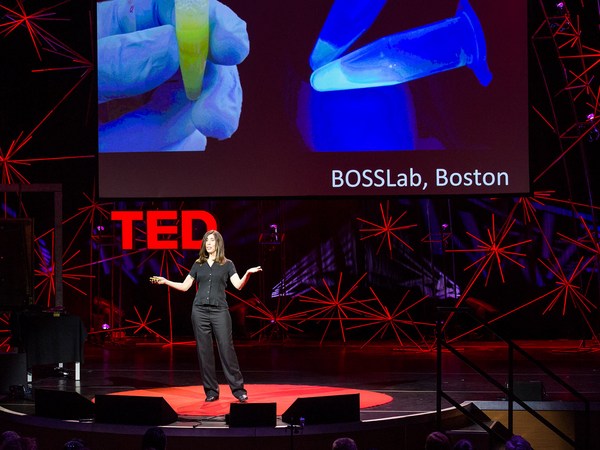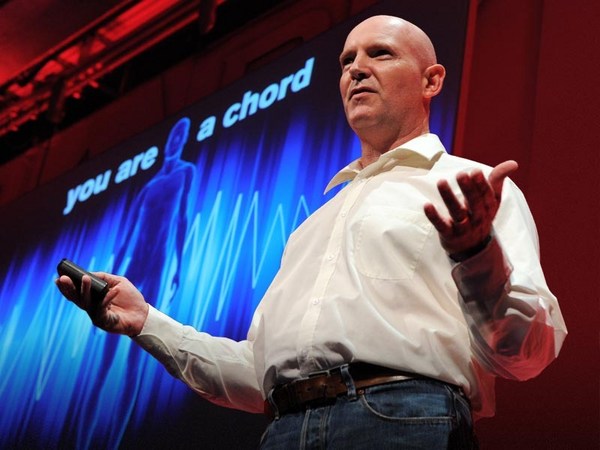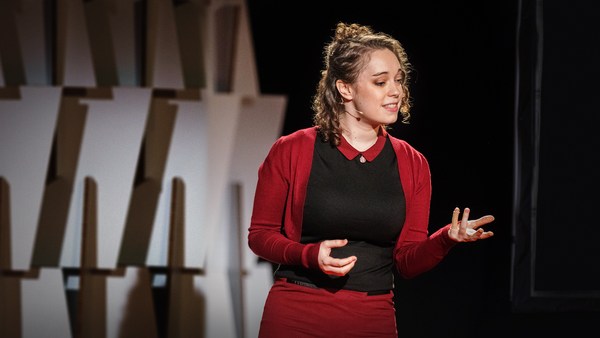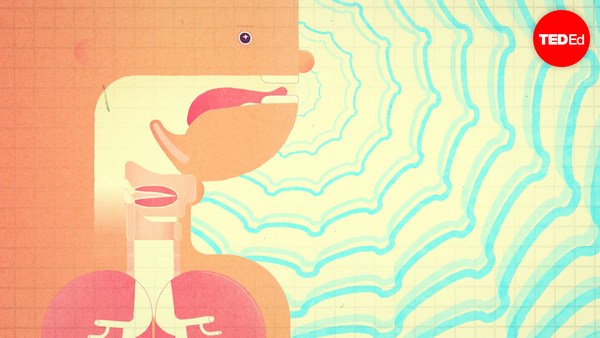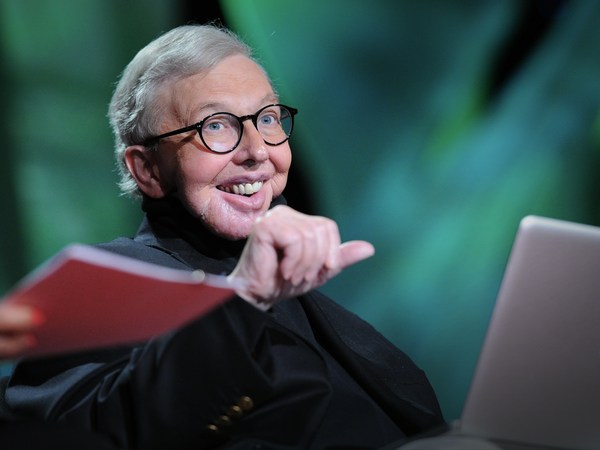I'd like to talk today about a powerful and fundamental aspect of who we are: our voice. Each one of us has a unique voiceprint that reflects our age, our size, even our lifestyle and personality. In the words of the poet Longfellow, "the human voice is the organ of the soul." As a speech scientist, I'm fascinated by how the voice is produced, and I have an idea for how it can be engineered. That's what I'd like to share with you.
I'm going to start by playing you a sample of a voice that you may recognize.
(Recording) Stephen Hawking: "I would have thought it was fairly obvious what I meant."
Rupal Patel: That was the voice of Professor Stephen Hawking. What you may not know is that same voice may also be used by this little girl who is unable to speak because of a neurological condition. In fact, all of these individuals may be using the same voice, and that's because there's only a few options available. In the U.S. alone, there are 2.5 million Americans who are unable to speak, and many of whom use computerized devices to communicate. Now that's millions of people worldwide who are using generic voices, including Professor Hawking, who uses an American-accented voice. This lack of individuation of the synthetic voice really hit home when I was at an assistive technology conference a few years ago, and I recall walking into an exhibit hall and seeing a little girl and a grown man having a conversation using their devices, different devices, but the same voice. And I looked around and I saw this happening all around me, literally hundreds of individuals using a handful of voices, voices that didn't fit their bodies or their personalities. We wouldn't dream of fitting a little girl with the prosthetic limb of a grown man. So why then the same prosthetic voice? It really struck me, and I wanted to do something about this.
I'm going to play you now a sample of someone who has, two people actually, who have severe speech disorders. I want you to take a listen to how they sound. They're saying the same utterance.
(First voice)
(Second voice) You probably didn't understand what they said, but I hope that you heard their unique vocal identities.
So what I wanted to do next is, I wanted to find out how we could harness these residual vocal abilities and build a technology that could be customized for them, voices that could be customized for them. So I reached out to my collaborator, Tim Bunnell. Dr. Bunnell is an expert in speech synthesis, and what he'd been doing is building personalized voices for people by putting together pre-recorded samples of their voice and reconstructing a voice for them. These are people who had lost their voice later in life. We didn't have the luxury of pre-recorded samples of speech for those born with speech disorder. But I thought, there had to be a way to reverse engineer a voice from whatever little is left over.
So we decided to do exactly that. We set out with a little bit of funding from the National Science Foundation, to create custom-crafted voices that captured their unique vocal identities. We call this project VocaliD, or vocal I.D., for vocal identity.
Now before I get into the details of how the voice is made and let you listen to it, I need to give you a real quick speech science lesson. Okay? So first, we know that the voice is changing dramatically over the course of development. Children sound different from teens who sound different from adults. We've all experienced this. Fact number two is that speech is a combination of the source, which is the vibrations generated by your voice box, which are then pushed through the rest of the vocal tract. These are the chambers of your head and neck that vibrate, and they actually filter that source sound to produce consonants and vowels. So the combination of source and filter is how we produce speech. And that happens in one individual.
Now I told you earlier that I'd spent a good part of my career understanding and studying the source characteristics of people with severe speech disorder, and what I've found is that even though their filters were impaired, they were able to modulate their source: the pitch, the loudness, the tempo of their voice. These are called prosody, and I've been documenting for years that the prosodic abilities of these individuals are preserved. So when I realized that those same cues are also important for speaker identity, I had this idea. Why don't we take the source from the person we want the voice to sound like, because it's preserved, and borrow the filter from someone about the same age and size, because they can articulate speech, and then mix them? Because when we mix them, we can get a voice that's as clear as our surrogate talker -- that's the person we borrowed the filter from— and is similar in identity to our target talker. It's that simple. That's the science behind what we're doing.
So once you have that in mind, how do you go about building this voice? Well, you have to find someone who is willing to be a surrogate. It's not such an ominous thing. Being a surrogate donor only requires you to say a few hundred to a few thousand utterances. The process goes something like this.
(Video) Voice: Things happen in pairs.
I love to sleep.
The sky is blue without clouds.
RP: Now she's going to go on like this for about three to four hours, and the idea is not for her to say everything that the target is going to want to say, but the idea is to cover all the different combinations of the sounds that occur in the language. The more speech you have, the better sounding voice you're going to have. Once you have those recordings, what we need to do is we have to parse these recordings into little snippets of speech, one- or two-sound combinations, sometimes even whole words that start populating a dataset or a database. We're going to call this database a voice bank. Now the power of the voice bank is that from this voice bank, we can now say any new utterance, like, "I love chocolate" -- everyone needs to be able to say that— fish through that database and find all the segments necessary to say that utterance.
(Video) Voice: I love chocolate.
RP: So that's speech synthesis. It's called concatenative synthesis, and that's what we're using. That's not the novel part. What's novel is how we make it sound like this young woman.
This is Samantha. I met her when she was nine, and since then, my team and I have been trying to build her a personalized voice. We first had to find a surrogate donor, and then we had to have Samantha produce some utterances. What she can produce are mostly vowel-like sounds, but that's enough for us to extract her source characteristics. What happens next is best described by my daughter's analogy. She's six. She calls it mixing colors to paint voices. It's beautiful. It's exactly that. Samantha's voice is like a concentrated sample of red food dye which we can infuse into the recordings of her surrogate to get a pink voice just like this.
(Video) Samantha: Aaaaaah.
RP: So now, Samantha can say this.
(Video) Samantha: This voice is only for me. I can't wait to use my new voice with my friends.
RP: Thank you. (Applause)
I'll never forget the gentle smile that spread across her face when she heard that voice for the first time. Now there's millions of people around the world like Samantha, millions, and we've only begun to scratch the surface. What we've done so far is we have a few surrogate talkers from around the U.S. who have donated their voices, and we have been using those to build our first few personalized voices. But there's so much more work to be done. For Samantha, her surrogate came from somewhere in the Midwest, a stranger who gave her the gift of voice. And as a scientist, I'm so excited to take this work out of the laboratory and finally into the real world so it can have real-world impact. What I want to share with you next is how I envision taking this work to that next level. I imagine a whole world of surrogate donors from all walks of life, different sizes, different ages, coming together in this voice drive to give people voices that are as colorful as their personalities. To do that as a first step, we've put together this website, VocaliD.org, as a way to bring together those who want to join us as voice donors, as expertise donors, in whatever way to make this vision a reality.
They say that giving blood can save lives. Well, giving your voice can change lives. All we need is a few hours of speech from our surrogate talker, and as little as a vowel from our target talker, to create a unique vocal identity.
So that's the science behind what we're doing. I want to end by circling back to the human side that is really the inspiration for this work. About five years ago, we built our very first voice for a little boy named William. When his mom first heard this voice, she said, "This is what William would have sounded like had he been able to speak." And then I saw William typing a message on his device. I wondered, what was he thinking? Imagine carrying around someone else's voice for nine years and finally finding your own voice. Imagine that.
This is what William said: "Never heard me before."
Thank you.
(Applause)
